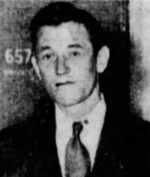 The Philadelphia Inquirer, May 2, 1951. In February 1939, on his day off from work at a New York City restaurant, Rudolph Sheeler visited his ailing sister in a Philadelphia, Pennsylvania, hospital. Upon his arrival, Sheeler was arrested for a string of armed robberies and murders that began in 1936. After giving a false confession, he was found guilty of the charges and sentenced to life in prison. Twelve years later, the conviction was reversed, and Sheeler was acquitted. On November 23, 1936, police officer James T. Morrow was murdered near a Sears, Roebuck plant in Philadelphia, Pennsylvania. Morrow was close on the tail of the perpetrator of a string of armed robberies in the area. A suspect, George Bilger, was arrested six months later. Bilger confessed and was sentenced to life in prison. The robberies continued, however, and on September 12, 1938, schoolteacher Edward Tamkin was murdered. Four months later, on January 23, 1939, a woman tipped off head of Philadelphia Detectives Division Captain Ryan that mobster Jack Howard (alias Jack Batton) was committing the crimes. Two weeks later, on February 6, Ryan and detectives confronted him. The confrontation ended in a shootout, with Ryan killing Howard. After Howard died, police discovered three other guns that had been in his possession, including those that were used to kill Morrow and Tamkin. With Howard dead and the new weapons located, police began to look for a supposed accomplice. A detective was stationed at the hospital to apprehend anyone visiting Howard's girlfriend, patient Elizabeth Morgan. Ten days after Howard’s death, 23-year-old Rudolph Sheeler drove to Philadelphia from New York to visit his sister, Elizabeth Morgan, in the hospital. Sheeler was arrested and charged with the murder of Officer Morrow, the murder of Edward Tamkin, and several counts of armed robbery. Subjected to physical and psychological coercion and denied the opportunity to communicate with his family or a lawyer, Sheeler confessed. Sheeler pleaded guilty and was sentenced to life in prison. George Bilger was subsequently released from prison, pardoned by the governor, and transferred to a mental hospital. Twelve years later, in 1951, University of Pennsylvania Law School professors Louis B. Schwartz and Raymond J. Bradley, aided by attorney Herbert L. Maris, learned of Sheeler’s case and brought it to the attention of the Pennsylvania Supreme Court. They provided documents proving that Sheeler was at work in New York City at the time of Morrow’s murder. The Supreme Court ordered Judge Louis E. Levinthal of the Court of Common Pleas to conduct a hearing on the new facts of the case and to submit a report of his findings. Judge Levinthal found that Sheeler’s confession was false and inconsistent with the facts known to police and that police had used brutality to force that confession. In March 1951, Judge Levinthal reversed Sheeler’s conviction and directed a verdict of acquittal. Judge James Gordon, Quarter Session, granted the acquittal on May l, 1951, and Sheeler was released. Six police officers, including an assistant superintendent, were immediately suspended for their involvement in the beating, threatening, and intimidation that had led to Sheeler’s false confessions. Sheeler received no compensation for his twelve years of imprisonment. – Researched by Willie Jamison
|